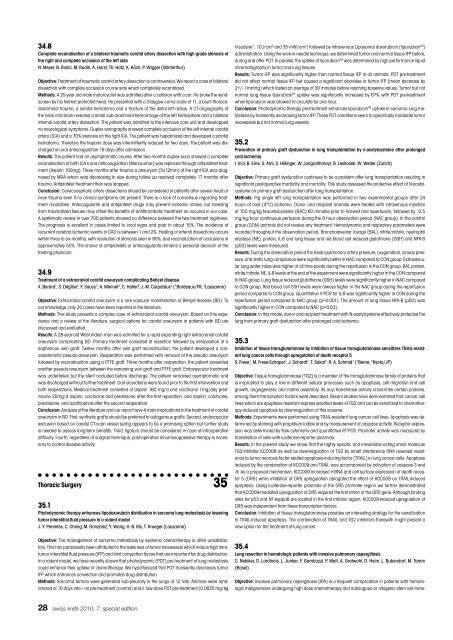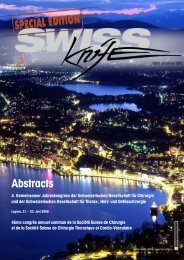Anorectal Manometry in 3D NEW! - Swiss-knife.org
Anorectal Manometry in 3D NEW! - Swiss-knife.org
Anorectal Manometry in 3D NEW! - Swiss-knife.org
Create successful ePaper yourself
Turn your PDF publications into a flip-book with our unique Google optimized e-Paper software.
34.8<br />
Complete recanalisation of a bilateral traumatic carotid artery dissection with high grade stenosis of<br />
the right and complete occlusion of the left side<br />
N. Meyer, B. Rodic, M. Rud<strong>in</strong>, A. Horst, Th. Hotz, K. Käch, P. Wigger (W<strong>in</strong>terthur)<br />
Objective: Treatment of traumatic carotid artery dissection is controversial. We report a case of bilateral<br />
dissection with complete occlusion on one side which completely recanalized.<br />
Methods: A 25-year old male motorcyclist was admitted after a collision with a car. He broke the w<strong>in</strong>dscreen<br />
by his helmet protected head. He presented with a Glasgow coma scale of 11, a blunt thoracoabdom<strong>in</strong>al<br />
trauma, a scrotal hematoma and a fracture of the distal left radius. A CT-angiography of<br />
the neck and bra<strong>in</strong> revealed a small sub-arachnoid-hemorrhage of the left hemisphere and a bilateral<br />
<strong>in</strong>ternal carotid artery dissection. The patient was admitted to the <strong>in</strong>tensive care unit and developped<br />
no neurological symptoms. Duplex sonography showed complete occlusion of the left <strong>in</strong>ternal carotid<br />
artery (ICA) and a 70% stenosis on the right ICA. The patient was hepar<strong>in</strong>ized and developed a scrotal<br />
hematoma. Therefore the hepar<strong>in</strong> dose was <strong>in</strong>termittently reduced for two days. The patient was discharged<br />
on oral anticoagulation 16 days after admission.<br />
Results: The patient had an asymptomatic course. After two months duplex scan showed a complete<br />
recanalisation of both ICA’s and anticoagulation (Marcoumar) was replaced through antiplatelet treatment<br />
(Aspir<strong>in</strong> 100mg). Three months after trauma a aneurysm (5x12mm) of the right ICA was diagnosed<br />
by MRA which was decreas<strong>in</strong>g <strong>in</strong> size dur<strong>in</strong>g follow up resolved completely 17 months after<br />
trauma. Antiplatelet treatment then was stopped.<br />
Conclusion: Cervicocephalic artery dissections should be considered <strong>in</strong> patients after severe head or<br />
neck trauma even if no cl<strong>in</strong>ical symptoms are present. There is a lack of consensus regard<strong>in</strong>g treatment<br />
modalities. Anticoagulants and antiplatelet drugs may prevent ischemic stroke, but bleed<strong>in</strong>g<br />
from traumatized tissues may offset the benefits of antithrombotic treatment as occured <strong>in</strong> our case.<br />
A systematic review <strong>in</strong> over 700 patients showed no difference between the two treatment regimens.<br />
The prognosis is excellent <strong>in</strong> cases limited to local signs and poor <strong>in</strong> about 15%. The <strong>in</strong>cidence of<br />
recurrent cerebral ischemic events <strong>in</strong> CAD is between 1 and 2%. Heal<strong>in</strong>g of arterial dissections occurs<br />
with<strong>in</strong> three to six months, with resolution of stenosis seen <strong>in</strong> 90%, and recanalization of occlusions <strong>in</strong><br />
approximately 50%. The choice of antiplatelets or anticoagulants rema<strong>in</strong>s a personal decision of the<br />
treat<strong>in</strong>g physician.<br />
34.9<br />
Treatment of a extracranial carotid aneurysm complicat<strong>in</strong>g Behçet disease.<br />
X. Berard 1 , S. Déglise 2 , F. Saucy 2 , A. Mennet 2 , C. Haller 2 , J.-M. Corpataux 2 ( 1 Bordeaux/FR, 2 Lausanne)<br />
Objective: Extracranial carotid aneurysm is a rare vascular manifestation of Behçet disease (BD). To<br />
our knowledge, only 20 cases have been reported <strong>in</strong> the literature.<br />
Methods: This study presents a complex case of extracranial carotid aneurysm. Based on this experience<br />
and a review of the literature, surgical options for carotid aneurysm <strong>in</strong> patients with BD are<br />
discussed and evaluated.<br />
Results: A 28-year-old West Indian man was admitted for a rapid expand<strong>in</strong>g right extracranial carotid<br />
aneurysm complicat<strong>in</strong>g BD. Primary treatment consisted of resection followed by <strong>in</strong>terposition of a<br />
saphenous ve<strong>in</strong> graft. Twelve months after ve<strong>in</strong> graft reconstruction, the patient developed a nonanastomotic<br />
pseudo-aneurysm. Reoperation was performed with removal of the pseudo aneurysm<br />
followed by reconstruction us<strong>in</strong>g a PTFE graft. Three months after reoperation, the patient presented<br />
another pseudo-aneurysm between the rema<strong>in</strong><strong>in</strong>g ve<strong>in</strong> graft and PTFE graft. Endovascular treatment<br />
was undertaken but the stent occluded before discharge. The patient rema<strong>in</strong>ed asymptomatic and<br />
was discharged without further treatment. Oral ulcerations were found prior to the first <strong>in</strong>tervention and<br />
both reoperations. Medical treatment consisted of aspir<strong>in</strong> 160 mg/d and colchic<strong>in</strong>e 1mg/day prednisone<br />
20mg/d aspir<strong>in</strong>, colchic<strong>in</strong>e and prednisone after the first reparation, and aspir<strong>in</strong>, colchic<strong>in</strong>e,<br />
prednisone, and azathiopr<strong>in</strong>e after the second reoperation.<br />
Conclusion: Analysis of the literature and our report have 4 ma<strong>in</strong> implications <strong>in</strong> the treatment of carotid<br />
aneurysm <strong>in</strong> BD. First, synthetic grafts should be preferred to autogenous grafts. Second, endovascular<br />
exclusion based on careful CT-scan vessel siz<strong>in</strong>g appears to be a promis<strong>in</strong>g option but further study<br />
is needed to assess long-term benefits. Third, ligature should be considered <strong>in</strong> case of <strong>in</strong>traoperative<br />
difficulty. Fourth, regardless of surgical technique, post-operative <strong>in</strong>numosuppessive therapy is necessary<br />
to control disease activity.<br />
Thoracic Surgery 35<br />
35.1<br />
Photodynamic therapy enhances lipodoxorubc<strong>in</strong> distribution <strong>in</strong> sarcoma lung metastasis by lower<strong>in</strong>g<br />
tumor <strong>in</strong>terstitial fluid pressure <strong>in</strong> a rodent model<br />
J. Y. Perentes, C. Cheng, M. Gonzalez, Y. Wang, H.-B. Ris, T. Krueger (Lausanne)<br />
Objective: The management of sarcoma metastasis by systemic chemotherapy is often unsatisfactory.<br />
This has paradoxally been attributed to the leak<strong>in</strong>ess of tumor neovessels which <strong>in</strong>duce high <strong>in</strong>tratumor<br />
<strong>in</strong>terstitial fluid pressure (IFP) and limit convection forces that are important for drug distribution.<br />
In a rodent model, we have recently shown that photodynamic (PDT) pre treatment of lung metastasis<br />
could enhance their uptake of chemotherapy. We hypothesized that PDT transiently decreases tumor<br />
IFP which enhances convection and promotes drug distribution.<br />
Methods: Sarcoma tumors were generated sub-pleurally <strong>in</strong> the lungs of 12 rats. Animals were randomized<br />
at 10 days <strong>in</strong>to i. no pre-treatment (control) and ii. low dose PDT pre-treatment (0.0625 mg/kg<br />
28 swiss <strong>knife</strong> 2010; 7: special edition<br />
Visudyne ® , 10J/cm 2 and 35 mW/cm 2 ) followed by <strong>in</strong>travenous Liposomal doxorubic<strong>in</strong> (liporubic<strong>in</strong> TM )<br />
adm<strong>in</strong>istration. Us<strong>in</strong>g the wick-<strong>in</strong>-needle technique, we determ<strong>in</strong>ed tumor and normal tissue IFP before,<br />
dur<strong>in</strong>g and after PDT. In parallel, the uptake of liporubic<strong>in</strong> TM was determ<strong>in</strong>ed by high performance liquid<br />
chromatography <strong>in</strong> tumor and lung tissues.<br />
Results: Tumor IFP was significantly higher than normal tissue IFP <strong>in</strong> all animals. PDT pre-treatment<br />
did not affect normal tissue IFP but caused a significant decrease <strong>in</strong> tumor IFP (mean decrease by<br />
2+/- 1mmHg) which lasted an average of 30 m<strong>in</strong>utes before reach<strong>in</strong>g basel<strong>in</strong>e values. Tumor but not<br />
normal lung tissue liporubic<strong>in</strong> TM uptake was significantly <strong>in</strong>creased by 67% with PDT pre-treatment<br />
when liporubic<strong>in</strong> was allowed to circulate for one hour.<br />
Conclusion: Photodynamic therapy pre-treatment enhances liporubic<strong>in</strong> TM uptake <strong>in</strong> sarcoma lung metastasis<br />
by transiently decreas<strong>in</strong>g tumor IFP. These PDT conditions seem to specifically modulate tumor<br />
neovessels but not normal lung vessels.<br />
35.2<br />
Prevention of primary graft dysfunction <strong>in</strong> lung transplantation by n-acetylcyste<strong>in</strong>e after prolonged<br />
cold ischemia<br />
I. Inci, B. Erne, S. Arni, S. Hill<strong>in</strong>ger, W. Jungraithmayr, B. Leskosek, W. Weder (Zurich)<br />
Objective: Primary graft dysfunction cont<strong>in</strong>ues to be a problem after lung transplantation result<strong>in</strong>g <strong>in</strong><br />
significant postoperative morbidity and mortality. This study assessed the protective effect of N-acetylcyste<strong>in</strong>e<br />
on primary graft dysfunction after lung transplantation.<br />
Methods: Pig s<strong>in</strong>gle left lung transplantation was performed <strong>in</strong> two experimental groups after 24<br />
hours of cold (4°C) ischemia. Donor and recipient animals were treated with <strong>in</strong>travenous <strong>in</strong>jection<br />
of 150 mg/kg N-acetylcyste<strong>in</strong>e (NAC) 60 m<strong>in</strong>utes prior to harvest and reperfusion, followed by 12.5<br />
mg/kg/hour cont<strong>in</strong>uous perfusion dur<strong>in</strong>g the 8 hour observation period (NAC group). In the control<br />
group (CON) animals did not receive any treatment. Hemodynamic and respiratory parameters were<br />
recorded throughout the observation period. Bronchoalveolar lavage (BAL) nitrite/nitrate, neutrophil<br />
elastase (NE), prote<strong>in</strong>, IL-8 and lung tissue and red blood cell reduced glutathione (GSH) and NFK-B<br />
(p50) levels were measured.<br />
Results: Dur<strong>in</strong>g the observation period the mean pulmonary artery pressure, oxygenation, airway pressure,<br />
and static lung compliance were significantly better <strong>in</strong> NAC compared to CON group. Extravascular<br />
lung water <strong>in</strong>dex was higher at all time po<strong>in</strong>ts dur<strong>in</strong>g the reperfusion <strong>in</strong> the CON group. BAL prote<strong>in</strong>,<br />
nitrite/nitrate, NE, IL-8 levels at the end of the experiment were significantly higher <strong>in</strong> the CON compared<br />
to NAC group. Lung tissue reduced glutathione (GSH) levels were significantly higher <strong>in</strong> NAC compared<br />
to CON group. Red blood cell GSH levels were always higher <strong>in</strong> the NAC group dur<strong>in</strong>g the reperfusion<br />
period compared to CON group. Quantitative rt-PCR for IL-8 was significantly higher <strong>in</strong> CON dur<strong>in</strong>g the<br />
reperfusion period compared to NAC group (p=0.001). The amount of lung tissue NFK-B (p50) was<br />
significantly higher <strong>in</strong> CON compared to NAC (p=0.03).<br />
Conclusion: In this model, donor and recipient treatment with N-acetylcyste<strong>in</strong>e effectively protected the<br />
lung from primary graft dysfunction after prolonged cold ischemia.<br />
35.3<br />
Inhibition of tissue transglutam<strong>in</strong>ase by <strong>in</strong>hibition of tissue transglutam<strong>in</strong>ase sensitizes TRAIL-resistant<br />
lung cancer cells through upregulation of death receptor 5<br />
S. Frese 1 , M. Frese-Schaper 1 , J. Schardt 1 , T. Sakai 2 , R. A. Schmid 1 ( 1 Berne, 2 Kyoto/JP)<br />
Objective: Tissue transglutam<strong>in</strong>ase (TG2) is a member of the transglutam<strong>in</strong>ase family of prote<strong>in</strong>s that<br />
is implicated to play a role <strong>in</strong> different cellular processes such as apoptosis, cell migration and cell<br />
growth, angiogenesis, and matrix assembly. Its acyl transferase activity cross-l<strong>in</strong>ks certa<strong>in</strong> prote<strong>in</strong>s,<br />
among them transcription factors were described. Recent studies have demonstrated that cancer cell<br />
l<strong>in</strong>es which are apoptosis resistant express elevated levels of TG2 and can be sensitized to chemotherapy-<strong>in</strong>duced<br />
apoptosis by downregulation of this enzyme.<br />
Methods: Experiments were performed us<strong>in</strong>g TRAIL-resistant lung cancer cell l<strong>in</strong>es. Apoptosis was determ<strong>in</strong>ed<br />
by sta<strong>in</strong><strong>in</strong>g with propidium iodide and by measurement of caspase activity. Receptor expression<br />
was determ<strong>in</strong>ed by flow cytometry and quantitative RT-PCR. Promoter activity was measured by<br />
transfection of cells with lucifearse-reporter plasmids.<br />
Results: In the present study we show that the highly specific and irreversible act<strong>in</strong>g small molecule<br />
TG2-<strong>in</strong>hibitor KCC009 as well as downregulation of TG2 by small <strong>in</strong>terference RNA reversed resistance<br />
to tumor necrosis factor-related apoptosis-<strong>in</strong>duc<strong>in</strong>g factor (TRAIL) <strong>in</strong> lung cancer cells. Apoptosis<br />
<strong>in</strong>duced by the comb<strong>in</strong>ation of KCC009 and TRAIL was accompanied by activation of caspase-3 and<br />
-9. As a proposed mechanism, KCC009 <strong>in</strong>creased mRNA and cell surface expression of death receptor<br />
5 (DR5) while <strong>in</strong>hibition of DR5 upregulation abrogated the effect of KCC009 on TRAIL-<strong>in</strong>duced<br />
apoptosis. Us<strong>in</strong>g luciferase-reporter plasmids of the DR5 promoter region we further demonstrated<br />
that KCC009-mediated upregulation of DR5 required the first <strong>in</strong>tron of the DR5 gene. Although b<strong>in</strong>d<strong>in</strong>g<br />
sites for p53 and NF-kappaB are located <strong>in</strong> the first <strong>in</strong>tronic region, KCC009-<strong>in</strong>duced upregulation of<br />
DR5 was <strong>in</strong>dependent from these transcription factors.<br />
Conclusion: Inhibition of tissue transglutam<strong>in</strong>ase provides an <strong>in</strong>terest<strong>in</strong>g strategy for the sensitization<br />
to TRAIL-<strong>in</strong>duced apoptosis. The comb<strong>in</strong>ation of TRAIL and TG2 <strong>in</strong>hibitors therewith might present a<br />
new option for the treatment of lung cancer.<br />
35.4<br />
Lung resection <strong>in</strong> hematologic patients with <strong>in</strong>vasive pulmonary aspergillosis<br />
C. Nebiker, D. Lard<strong>in</strong>ois, L. Junker, F. Gambazzi, P. Matt, A. Gratwohl, D. Heim, L. Bubendorf, M. Tamm<br />
(Basel)<br />
Objective: Invasive pulmonary aspergillosis (IPA) is a frequent complication <strong>in</strong> patients with hematologic<br />
malignancies undergo<strong>in</strong>g high dose chemotherapy and autologous or allogenic stem cell trans-
















